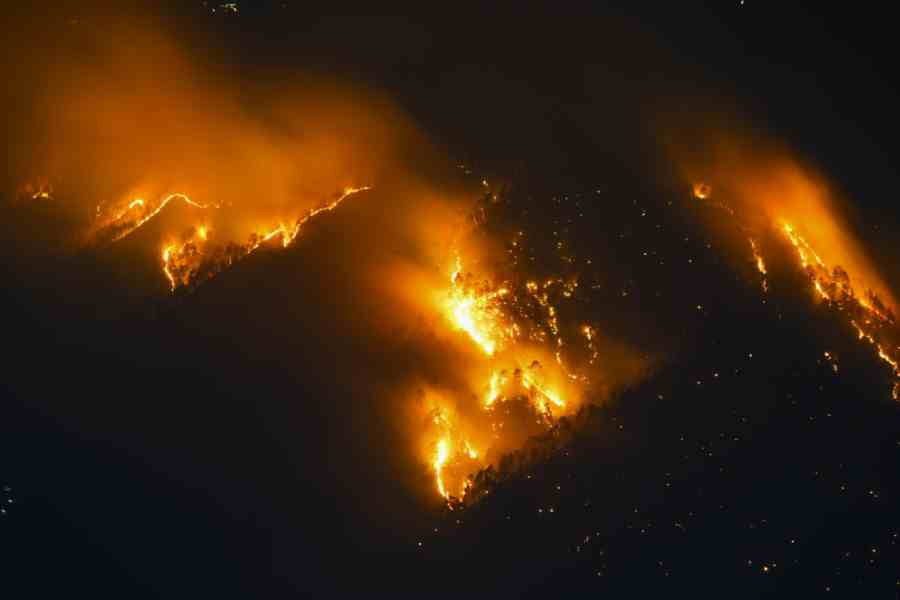“Among the environmental trends undermining our future are shrinking forests, expanding deserts, falling water tables, collapsing fisheries, disappearing species, and rising temperatures…. We are crossing natural thresholds that we cannot see and violating deadlines that we do not recognize.” — Lester R. Brown, an environmental analyst
The world has been witnessing the repercussions of climate change in the form of natural disasters, such as floods, droughts, landslides, cyclones, earthquakes and forest fires. In recent years, there has been a remarkable increase in the intensity and the frequency of forest fires at the global level according to the World Wildlife Fund International. Forest fires have become a major cause of concern owing to the devastation wrought to humans and livelihood losses. Presently, forest fires have affected 4% of the global forested area, comprising around 98 million hectares of forests. Based on forest inventory records in India, over half (54.40%) of the country’s forests are vulnerable to occasional fires. A smaller portion (7.49%) faces moderately frequent fires, and a relatively small area (2.40%) experiences high fire incidence. In 2001, sudden fires accounted for around 20% loss in forest cover, which has now
increased to more than 33% of forest loss in 2024.
Forest fires are drastically increasing annually, with 2020, 2021 and 2023 being the fourth, third and first worst years, respectively, of forest fires globally. An area about the size of Nicaragua, or nearly 12 million hectares, burned in 2023, surpassing the previous record by about 24%. In India, forest fires are concentrated in four key clusters, each with distinct causes. In the northwestern Himalayas, pine forests and intentional fires by graziers raise fire risks. In Northeast India, slash-and-burn agriculture often leads to fires. Central India’s deciduous forests are vulnerable due to extreme temperatures and sparse vegetation. The southern cluster, including the Western and the Eastern Ghats, faces fires driven by human activities and dry seasonal conditions.
From November 2023 to June 2024, Uttarakhand was the state most affected by forest fires, reporting 2,154 fires according to data from the Moderate Resolution Imaging Spectroradiometer. Odisha ranked second with 1,866 fire incidents, followed by Andhra Pradesh (1,788), Maharashtra (1,493), and Chhattisgarh (1,330).
The peak season for forest fires in India typically occurs during the dry, hot months of March to June, creating ideal fire conditions due to high temperatures and low humidity. Experts suggest three main causes that lead to the spread of forest fires: fuel (dry leaves serve as fuel), oxygen and heat. Forest fires are mainly the result of anthropogenic activities, unlike earlier times when forest fires were considered natural phenomena owing to, say, lightning strikes and high atmospheric pressure and dryness. The WWFI has noted that more than 75% of forest fires are attributed to humans. Human activities resulting in uncontrolled forest fires include industrial operations in proximity to forest areas, improper tourist behaviour, agricultural burning practices, deliberate arson, electrical malfunctions, careless disposal of smoking materials, and changing land-use patterns.
Forest fires have complex impacts on ecosystems. They cause tree cover loss, expose soil to erosion, deplete nutrients, and destroy essential organic matter. Regeneration is often hindered by repeated fires preventing full recovery and damaging plantations. Forest productivity declines as evergreen forests degrade into less diverse, fire-resistant species. Fires also increase flood risks by destroying ground cover and significantly harm wildlife. Along with this, property, wildlife and revenues for the government are lost to forest fires, and livelihoods, health and well-being of millions are disrupted. Forest fires have been a natural part of many ecosystems, promoting forest health and regeneration. Controlled burns help reduce fuel loads, preventing larger fires, and ash enriches the soil with nutrients. Fires also remove undergrowth, allowing sunlight to benefit native species and aid in pest control and the growth of fire-dependent species. However, these benefits are marginal compared to the losses associated with forest fires.
The management of wildfires involves five key phases, collectively known as the 5Rs: Review and Analysis — analyse past wildfires to understand key factors and improve future strategies; Risk Reduction — take action to decrease wildfire likelihood and impact, such as fuel management and architectural design; Readiness — prepare communities and fire services with plans, training and resources; Response — manage the wildfire with resource allocation, alerts and evacuations; Recovery — remediate and restore affected areas after a wildfire.
Forest fire management in India is a multi-faceted effort that involves various levels of government, local communities, and technological advancements. The ministry of environment, forest and climate change formulated a National Action Plan on Forest Fires (2018) that focusses on enabling and empowering local communities and allows the use of real-time data analysis to prevent and manage forest fires. Local communities play a vital role through Joint Forest Management Committees in the early detection and prevention of fires.
Technological advancements, such as the Visible Infrared Imaging Radiometer Suite, NASA’s MODIS and Geographic Information System Mapping, play a significant role in forest fire detection, prevention and management of resources. Additionally, public awareness campaigns, restricted forest access during fire season, and active management of high-risk areas help reduce fire risks. Indirect measures like deforestation control, land rehabilitation, and private sector involvement are crucial for long-term sustainability. Together, these efforts aim to protect India’s forests from increasing fire threats, emphasising proactive prevention over reactive firefighting.
The silence of burned landscapes speaks volumes. But within that silence lies a powerful echo, a call to action. Our legacy will be defined by how we respond to the cries of our burning forests. The causes are many — from natural occurrences to human negligence — but the devastation left behind by forest fires is unparalleled. Let us not be the generation that writes the final, tragic chapter in the story of our forests.
Avantika Tyagi and Ananya Arora are students at Christ University, Delhi; Amit Kumar is Assistant Professor, Department of Economics, Christ University, Delhi; Khushboo Aggarwal is Maharishi Kanad Postdoctoral Fellow, Delhi School of Public Policy and Governance, University of Delhi











